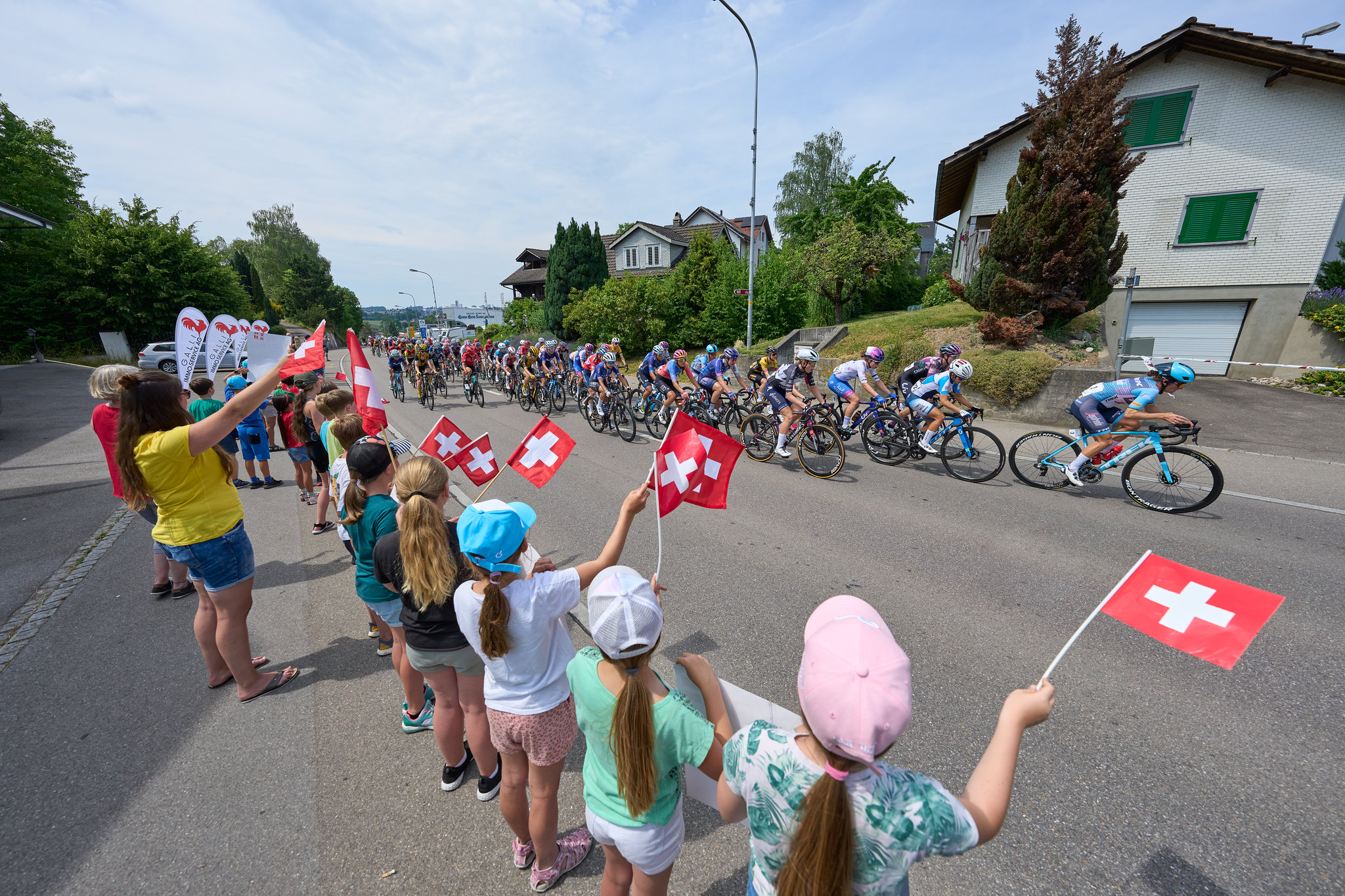

The fourth edition of Tour de Suisse Women will take place June 15-18 in the canton of Vaud, the French-speaking region of Switzerland, and feature four grueling stages, two of which will strongly favor the climbers. While the total length of the race may not appear very demanding at only 327.4km, the 6512 meters of ascending over the four days will more than make up for any shortfalls in the race’s overall distance.
Riders will need to be particularly attentive on the climbs in the first three stages, where steep ramps can undermine the efforts of even the best climbers who don’t pace themselves properly. And teams will also need to keep an eye on the Swiss alpine weather, which at this time of year can change from good, to bad, to worse in no time and wreak havoc on the descents.
SD Worx-Protime is the team favored to win and has expressed their goal as nothing less than overall victory. Team director Anna van der Breggen gave her thoughts on this year’s route in a recent press release.
“The first stage is very difficult right from the start,” said Van der Breggen. “The distance of the stage may be little at 59 kilometres, but the Col de la Croix is immediately very difficult. This is immediately a tough stage. The first two stages will largely determine what the classification will look like. Then we will know how to go into the last two beautiful stages.”
Past winners of this race are Marlen Reusser, Lucinda Brand, and Lizzie Deignan, while runner-ups have included riders such as Demi Vollering, Elise Chabbey, Kristen Faulkner, Elisa Longo Borghini, and Pauliena Rooijakkers.
Eighteen six-rider teams are scheduled to start this year’s race: 10 WorldTour teams (WWT), 7 Continental teams (CTW), and 1 Swiss team (NAT).
Favorites for this year’s edition are Demi Vollering (SD Worx-Protime), Gaie Realini, Elisa Longo Borghini (Lidl-Trek), Juliette Labous (dsm-firmenich PostNL), Évita Muzic (FDJ-SUEZ), and Kasia Niewiadoma (Canyon//SRAM).
THE ROUTE
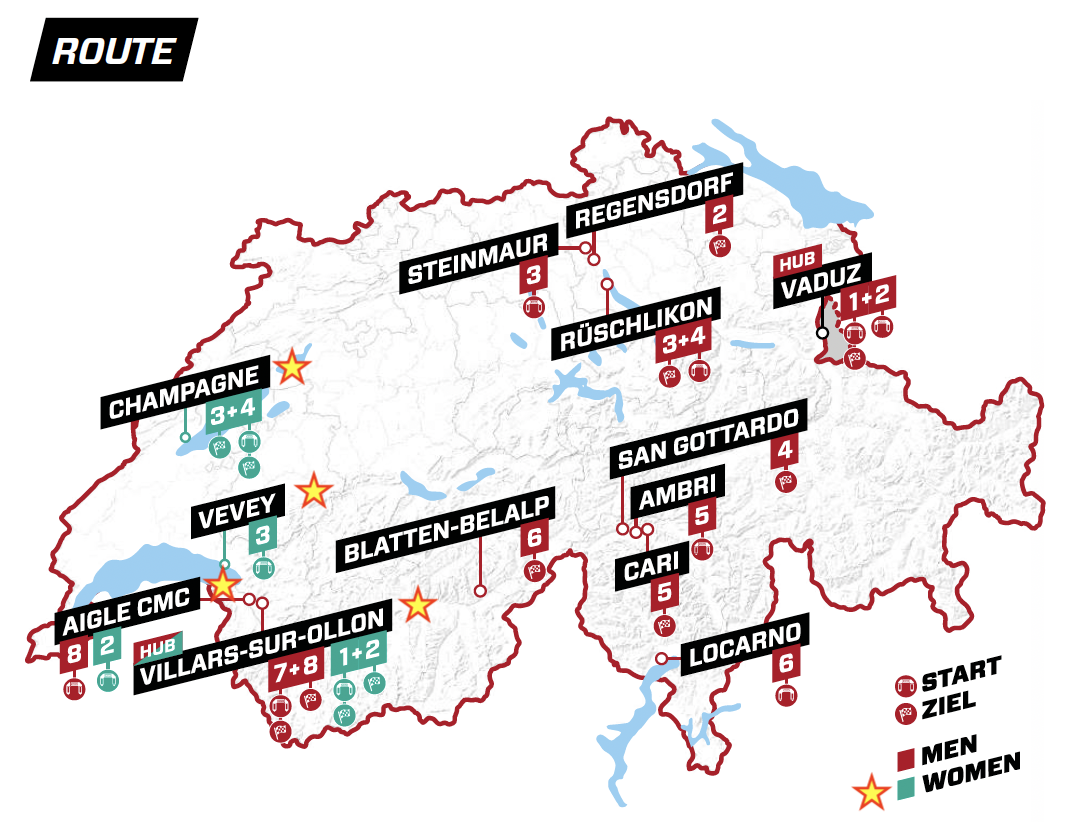
Stage 1: Villars-sur-Ollon > Villars-sur-Ollon (58.6km)
Stage 1 will start and finish in Villars-sur-Ollon, a Swiss ski resort in the heart of the Vaud Alps sitting at an altitude of 1300 meters with a view of Mont Blanc and Dents du Midi. But with over 1500 meters of climbing in less than 60 kilometers, the peloton won’t have much time for sightseeing as this stage may prove to be the most difficult one.
Right from the start, the peloton will begin climbing up towards the category 2 climb, Col de la Croix (3.8km/8.9%), which peaks at 7.7km into the race. With such a short stage, this climb may prove to be more crucial to the GC riders than the last climb of the day if a select group of riders attack and escape over the top.
Following the Col de la Croix, the route descends into Aigle for about 25km, then hits a flat/false-flat section until the intermediate bonus sprint at 42.6km. Riders who are distanced on Col de la Croix should be able to regain contact with the peloton, but there are no guarantees that this will be possible with such a short stage.
After the intermediate bonus sprint at 42.6km, riders will have around 5km to catch their breath before the road begins a gentle ascent towards the start of the category 1 climb, Villars-sur-Ollon (7.3km/8.2%) at 50km. The gradient of this category 1 climb is a bit less than Col de La Croix, but it’s twice as long, with ramps in the final 3km hitting 10.7%, 13.4%, and 11.5%. These steep ramps will undoubtedly be the place where GC contender attack in a bid to gain extra time, if they haven’t already. Riders taken by surprise in these final kilometers could lose much time.
The final 500 meters to the finish is only 4.8%, but will surely feel as steep as the previous sections for any riders who decide to duke it out in a sprint. In all likeliness, this stage will establish the GC rankings and set a precedent for the remainder of the race.
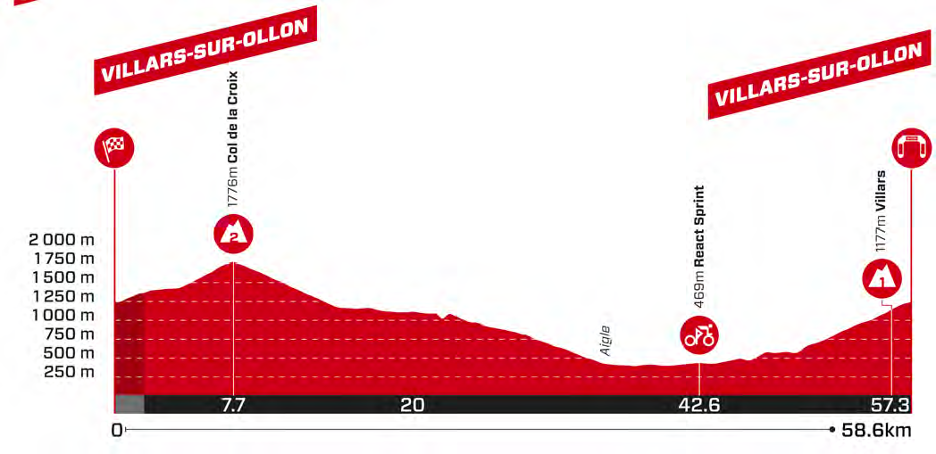
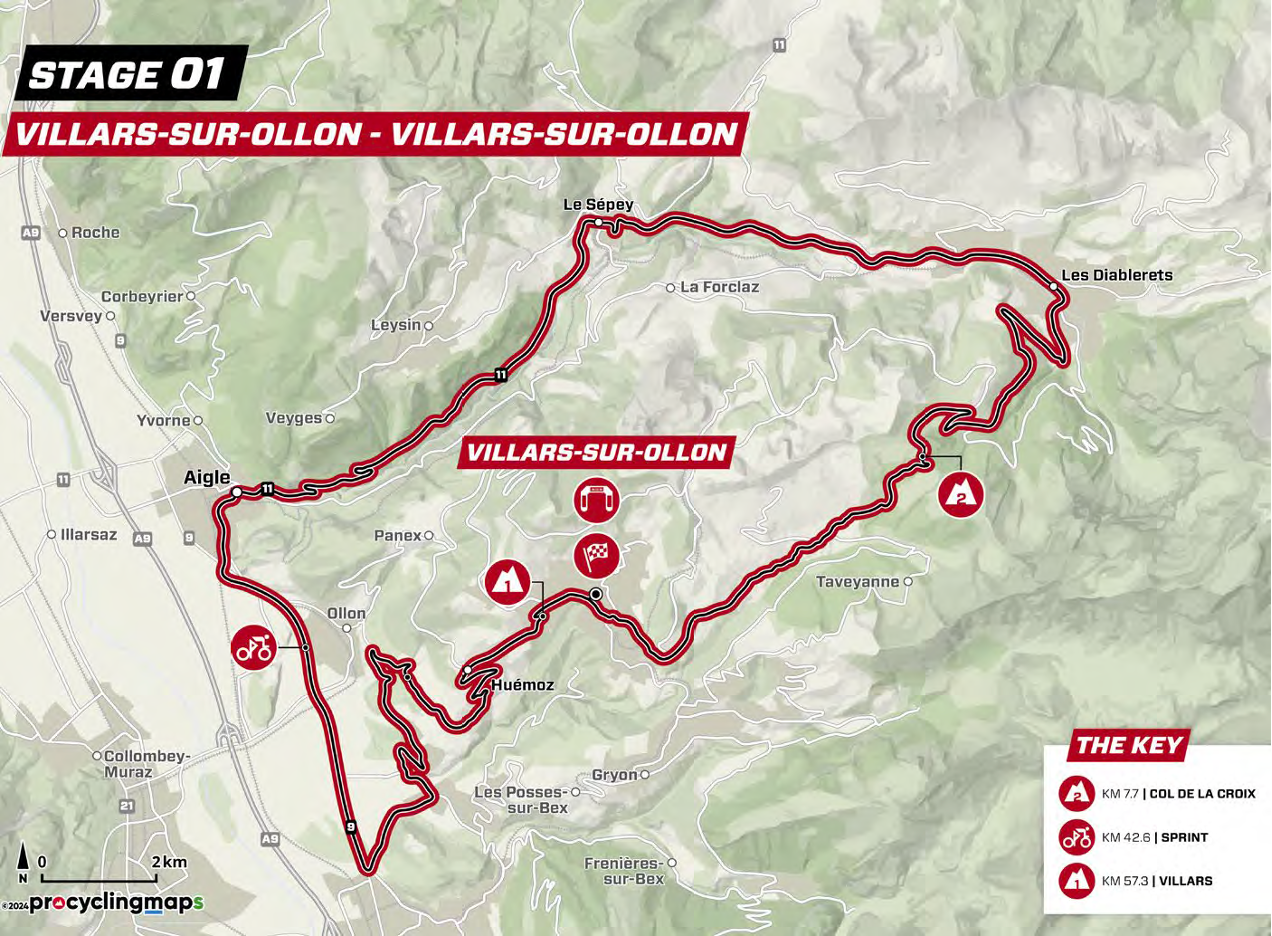
Stage 2: Aigle > Villars-sur-Ollon (15.7km ) Individual Time Trial
While time trial specialists will have an advantage in the first 5km of this 15.7km individual time trial, the final 10km are a climber’s dream with 865 meters of ascension – that’s an average of 8% over 10km. Breaking it down further, riders will hit three challenging sections at 7.5km (2.5km/8.7%), at 10.5km (2.8km/8.4%), and at 12km (1.4km/7.9%).
The last 3km averages 8.2% and will be very familiar to riders as it follows the same route as the previous day’s stage 1 finish. While climbers should surely dominate this stage, it may also depend on who has the best legs after the previous day’s demanding stage. Either way, any GC contenders who have a bad time trial will certainly suffer the consequences when the seconds – or minutes – are tallied up at the end of the day.
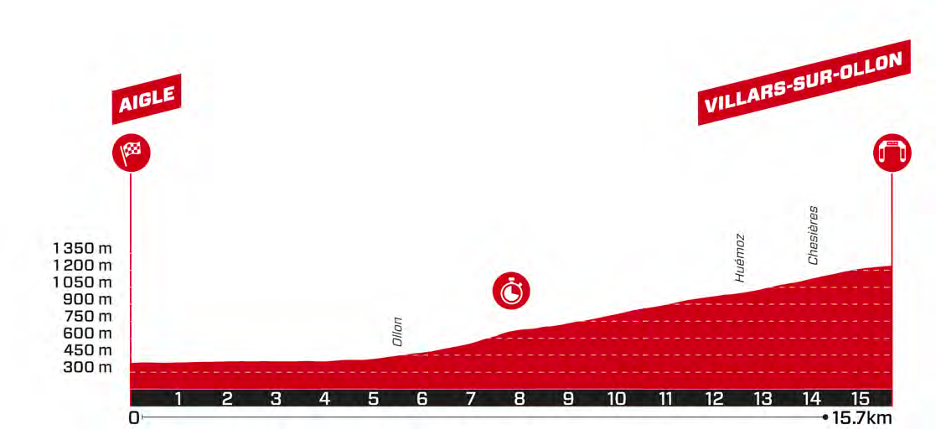
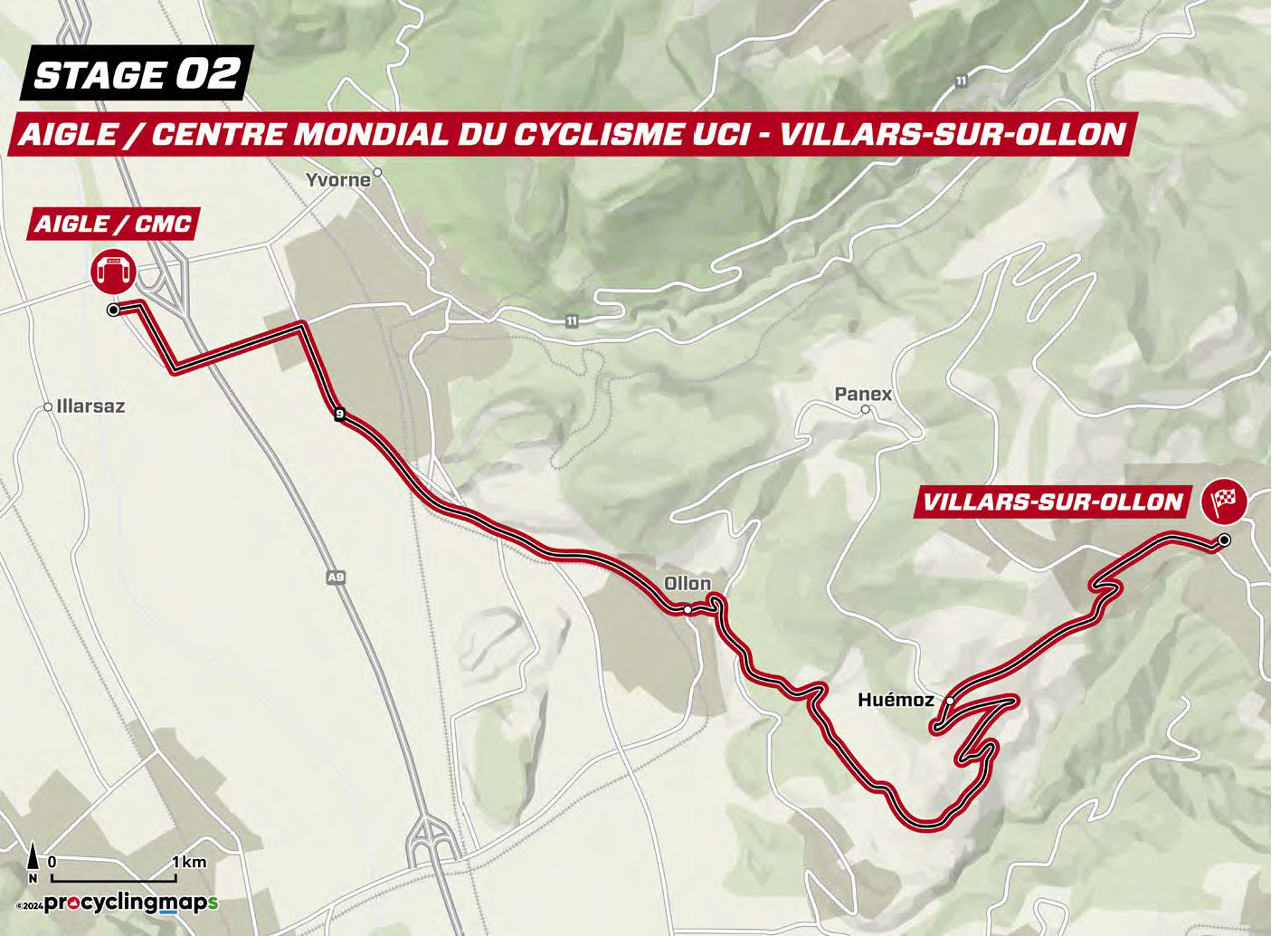
Stage 3: Vevey > Champagne (125.6km)
With 1993 meters of ascension on the menu, across four categorized climbs, stage three may turn out to be more demanding than expected, especially after two tough stages. Starting in Vevey, right on the north shore of Lake Leman, this stage begins climbing immediately in the first few kilometres as the peloton makes its way towards the category 2 climb, Chemin des Cournilles (1.2km/12.8%). Riders will crest the climb at 6.5km and then hit a lumpy, undulating section for almost 25km before they start the category 3 climb, Route de Thierrens (4.9km/4.7%) at 31.3km.
With GC contenders watching one another, either of these two early climbs could be an opportunity for riders low on the GC to attack and try for a stage win with a long-distance breakaway. But with 90km still remaining after the second climb, it will require an all-in commitment for any riders who choose to try it.
After the riders crest the second climb, Route de Thierrens (4.9km/4.7%) at 36.1km, it’s a long slog over more lumpy terrain for the next 50km until the 3rd climb begins at around 85km. Any riders that succeed in getting away in a group early on will more than likely see some of their breakaway companions fatiguing and dropping off before the category 3 climb, Sergey (1.6km/5%), is crested at 86.1km.
With almost 40km remaining after the climb Sergey, and an intermediate bonus sprint yet to come at 105.4km, the GC rivals will probably be content to wait until the category 2 climb, Vaugondry (4.3km/6.7%) at 108.3km, before they attempt any attacks.
Once the riders crest Vaugondry only 13km of racing remains, and if there are no riders off the front any sprinters who have survived may be rewarded with the chance of a sprint finish. Those riders who enjoy a tricky, technical finish will appreciate the 3 ninety degree corners in the last 500 meters.
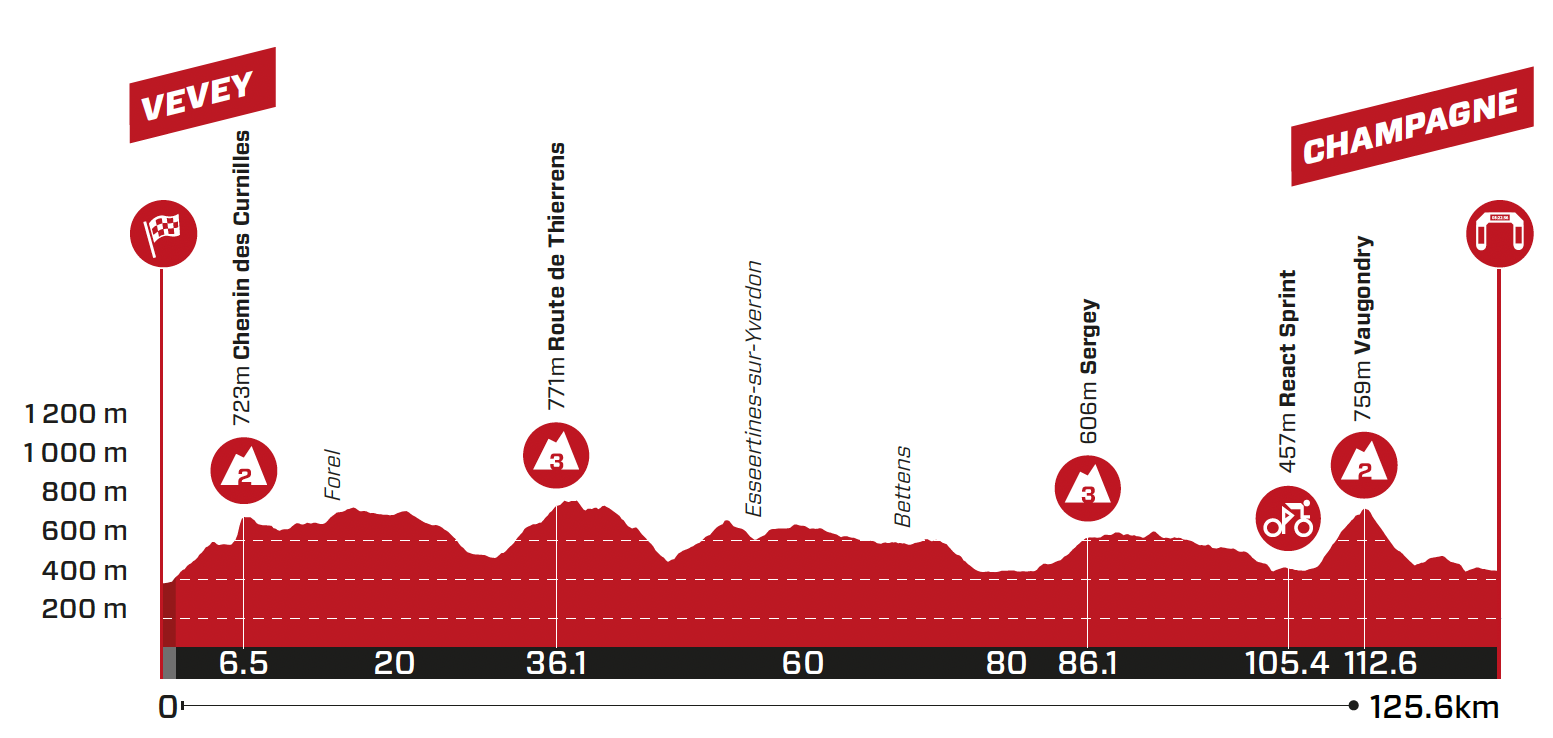
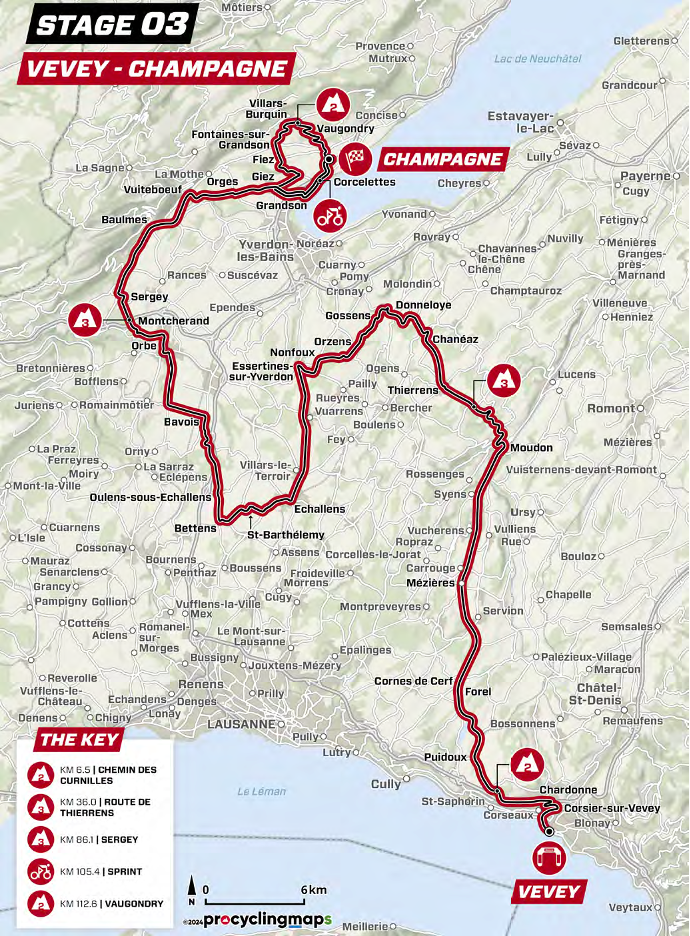
Stage 4: Champagne > Champagne (127.5km)
Starting and finishing in Champagne, on the southern edge of Lake Neuchâtel, stage 4 may not be a pure sprinter’s stage with 2124 meters of ascension, but for those riders who possess a good sprint, and some climbing ability, it may be a hidden opportunity for a victory. With the two category 2 climbs and most of the elevation gain coming in the first part of the stage, sprinters who can hang on until the last climb at 82.4km will have a very good chance if the stage comes down to a sprint.
Like stage 3, the race starts by ascending towards the first climb, the category 3 Col des Etroits (11.4km/4.9km), which officially begins at 9.8km and crests at 21.2km. As the longest climb of the race at 11.4km, this climb may creep up on GC riders and surprise their tired legs if their rivals choose to attack. But more than likely the attacks will come from those who are low on the GC and looking to get into early breakaway.
After cresting the first climb at 21.2km, riders will descend for around 10km then hit an uncategorized climb, Les Bayards, for another 10km that will take them to a plateau situated at around 1000 meters that runs for about 20km. This flat stretch of road may give a breakaway an advantage to gain some time on the peloton before the final climb, the category 2 Vue des Alpes (5.2km/4.7%), which begins at 77.2km.
For any riders hoping to get away before the finish, the Vue des Alpes climb may be their very last opportunity. At a gradient of only 4.7%, this climb may favor powerful riders who have not been able to succeed on the steeper climbs of the race, or be an opportunity for GC contenders who are still trying to move up and willing to risk their position.
After this climb crests at 82.5km, a long descent of almost 10km awaits followed by a false flat that will take the riders into Rochfort and then immediately down to Lake Neuchâtel where the intermediate bonus sprint will be contested at 108.9km.
The final 20km is flat and straight along the banks of the lake until the finish in Champagne and it will be very difficult for any riders to get away. If the peloton is still together, any sprinters who are left at this point will, once again, have a very good chance at victory. The finish is the same one as in stage 3 – a tricky, technical finish with 3 ninety degree corners in the last 500 meters.
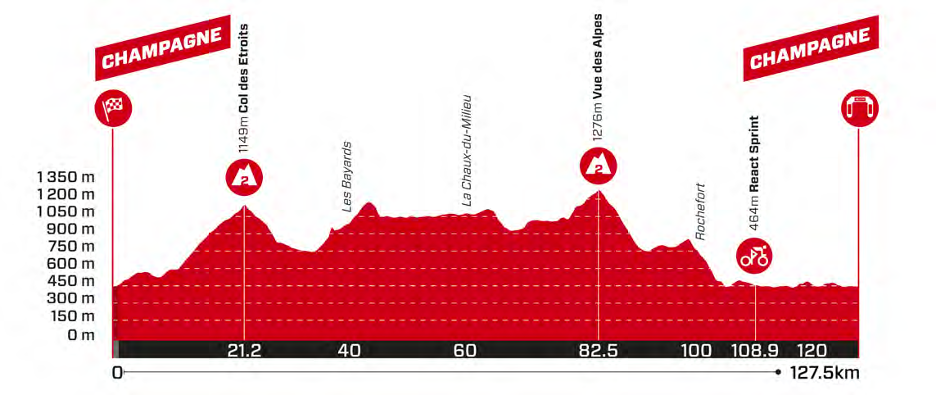
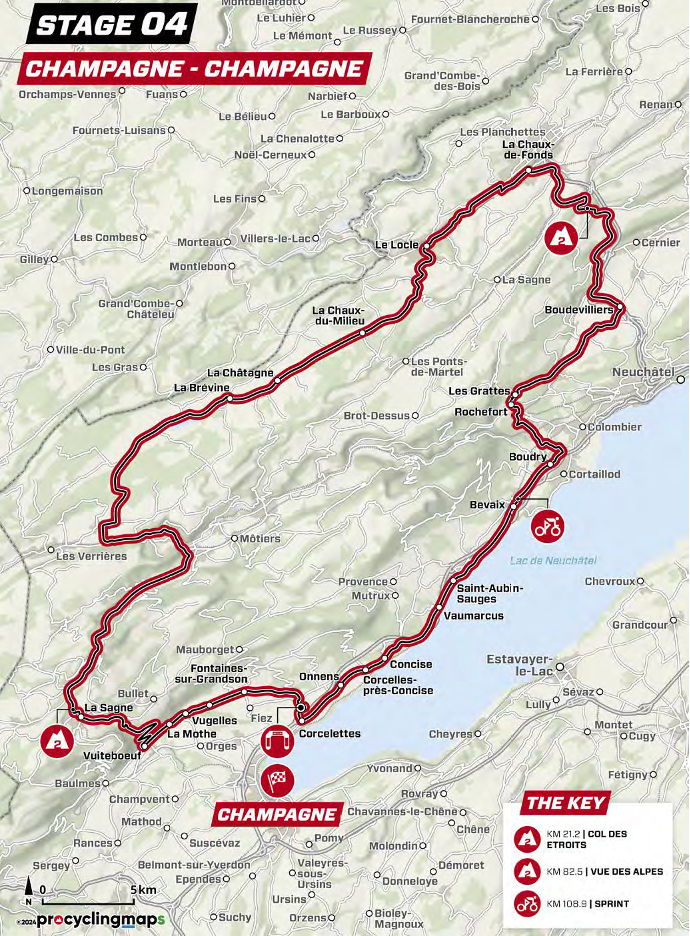
RIDERS TO WATCH
Last year’s winner Marlen Reusser (SD Worx-Protime) won’t be defending her title due to illness, but teammate Demi Vollering will be present with a strong team backing her for a GC win. After taking victories in Spain this past spring at Vuelta España Femenina, Itzulia Women, and Vuelta a Burgos Feminas, Vollering is by far the favorite to win. Alongside her she will have teammate Mischa Bredewold, who was runner-up at Itzulia Women and could play a role as GC leader, as well as climber Niamh Fisher-Black, who won stage 4 last year and was 7th overall at Vuelta España Femenina this year.
Évita Muzic (FDJ-Suez) is the only rider this year who has really been able to challenge Demi Vollering on the climbs. She showed this when she out-climbed Vollering in the final meters of stage 6 in this year’s Vuelta España Femenina, and with her excellent performance at Vuelta a Burgos Feminas, where she placed second to Vollering in the GC. Her weakness may be in her ability to consistently perform at a high level against Vollering and other climbers. Recently, at the French climber’s classic, Alpes Gresivaudan Classic (1.1), she was soundly beaten by more than a minute by Continental-level rider, Marion Bunel. It’s clear she will need to be more savvy with her tactics if she hopes to beat Vollering.
Lidl-Trek will be bringing a strong team with Elisa Longo Borghini, who was third overall in last year’s race and recently took third in this year’s Vuelta España Femenina. But with the hilly nature of this year’s route, teammate Gaie Realini may be better suited as the team’s GC leader. At a mere 40kg, Realini is pure climber and excels on steep gradients such as those that will appear in the final three kilometers of stage 1. Her weakness is on the flat terrain, where she tends to lose ground especially in windy conditions. If she can do well on stage 1 and perform well in the stage 2 time trial, she may have a shot at the GC podium.
Team dsm-firmenich PostNL will likely have Juliette Labous as their designated GC leader. Her recent GC performances at Vuelta España Femenina, where she was fourth, and Itzulia Women, where she was 3rd, make her a strong contender for a GC podium spot. Even though she may not be able to match Vollering on the climbs, her credentials as a stage racer cannot be overlooked. With two top five GC finishes in past editions of Tour de France Femmes (4th in ‘22 and 5th in ‘23), and a 2nd place in last year’s Giro d’Italia Donne, she has demonstrated the ability to perform at a high level in Grand Tours.
Kasia Niewiadoma (Canyon//SRAM) is another possible GC contender who finished fourth in last year’s race and has recently been training at altitude in the U.S. in Colorado. After finishing third at last year’s Tour de France Femmes, Niewiadoma was touted as Vollering’s main rival in the Grand Tours after Annemiek van Vleuten’s retirement. However, since her victory at La Flèche Wallonne Femmes this past April she hasn’t raced much, other than at Vuelta España Femenina, where she was ill and had to drop out before the last stage. So, it’s uncertain where her fitness level is and whether she will be contesting the GC or using the race to improve her fitness for upcoming races.
STARTLIST
SD Worx – Protime (WWT) Vollering, Bredewold, Fisher-Black, Gerritse, Schreiber, van den Broek-Blaak
Canyon//SRAM (WWT) Niewiadoma, Chabbey, Bradbury, Niedermaier, Skalniak-Sójka, Czapla
FDJ – SUEZ (WWT) Buijsman, Kraak, Wiel, Ludwig, Muzic
Fenix – Deceuninck (WWT) Stiasny, Kastelijn, van Alphen, van der Heijden, Worst, Schweinberger
Lidl – Trek (WWT) Longo Borghini, Realini, Spratt, Bäckstedt, Chapman, Wilson-Haffenden
Liv AlUla Jayco (WWT) Žigart, Andersson, Gåskjenn, Korevaar, Pate, Ton
Roland (WWT) Hartmann, Eklund, Kiesenhofer, Pirrone, Vettorello, Collinelli
dsm-firmenich PostNL (WWT) Ciabocco, Labous, Barale, Rayer, Storrie, Vinke
Visma|Lease a Bike (WWT) Achtereekte, Reijnhout, van Empel, Vigie, von Berswordt, de Vries
UAE Team ADQ (WWT) Harvey, Holden, Ivanchenko, Magnaldi, Włodarczyk, Carbonari
ARA|Skip Capital (CTW) Anderson, Carnes, Marr, Simpson, Stewart, Wales
Bepink – Bongioanni (CTW) Casagranda, Savi, Trinca Colonel, Colombi, Oro, Valtulini
Team Bridgelane (CTW) Appleton, Fuller, Raynolds, Ricardo, Bennett, Pollock
EF Education – Cannondale (CTW) Cadzow, Emond, Faulkner, Rüegg, Kessler
St Michel-Mavic-Auber93 (CTW) Bunel, Fahy, Guilman, Miermont, Roussel, Avoine
Tashkent City Women (CTW) Kakhorova, Kozieva, Misyurina, Zabelinskaya, Elmurodova, Golotina
VolkerWessels (CTW) Jansen, Stultiens, Vanpachtenbeke, Demey, Meert, van Bokhoven
Swiss National Team (NAT) Neff, Fuchs, Häberlin, Leu, Liechti, Tschenett
More Information